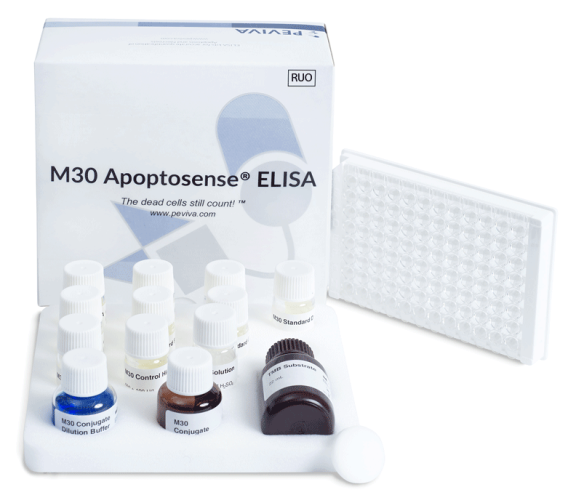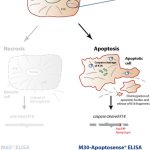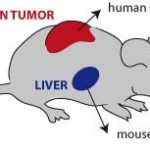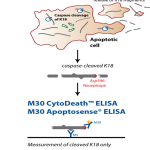
M30 Apoptosense® CK18 Kit
$0.00
The M30 Apoptosense® CK18 Kit (ELISA) is a unique tool for reliable and reproducible quantitative detection of apoptosis in epithelial keratin 18 (K18) (cytokeratin 18 [CK18]) positive cells. The specificity is reliable because the M30 Apoptosense® ELISA solely quantifies the accumulation of soluble caspase-cleaved keratin 18, a product of apoptosis. The assay is intended for subject serum or plasma. Another useful application is the detection of tumor apoptosis in mouse xenograft models using plasma samples.
M30 Apoptosense® is an ELISA assay based on the M30 monoclonal antibody (Leers et al., 1999). This antibody specifically binds caspase-cleaved keratin 18 (ccK18, caspase-celaved cytokeratin 18, ccCK18 or K18-Asp396) but does not bind native, uncleaved, K18. The M30 Apoptosense® assay therefore represents a specific quantitative test for apoptosis in epithelial cells (Hägg et al. 2002).
All reagents are provided in a convenient ready-for-use format. The separable strips provide the flexibility for your experimental design.
Because of the critical importance of apoptosis, numerous application fields exists, but particularly:
- Hepatology: Research shows that apoptosis is increased in liver disease. CK18 is highly abundant and critical for normal livers. Apoptosis can be measured in liver disease subjects.
- Oncology: Measures chemotherapy induced apoptosis in epithelial carcinoma in research
- Toxicology: Suitable for studies when evaluating different pharmaceutical agents’ impact on liver cell death
Note: M30 Apoptosense® ELISA was previously sold under catalog # P10010.
| M5 Coated Microstrips | One microplate, 12 strips with 8 wells each, 96 dry wells in total. The wells are coated with mouse monoclonal K18 antibody M5. The microplate is sealed in an aluminium bag, which contains a desiccating device. If not all the strips are used, reseal the bag and keep the desiccating device inside. Ready for use! |
|---|---|
| M30 Conjugate | Concentrate (24 × conc). One vial containing 0.4 mL of mouse monoclonal M30 antibody (anti-K18Asp396 neo-epitope) conjugated with horseradish peroxidase (HRP) in phosphate buffer with protein stabilizers. Preservative added. Should be diluted with M30 Conjugate Dilution Buffer. Note: Do not expose to light. |
| M30 Conjugate Dilution Buffer | One vial containing 11 mL of phosphate buffer with protein stabilizers for dilution of the M30 Conjugate. Preservative added. Blue colored. |
| M30 Standard A–G | Standard A containing 2 mL of phosphate buffer with fetal calf serum (FCS). Standard B–G, 0.5 mL each, containing standard material in phosphate buffer with FCS. The values of Standard A–G are 0, 75, 150, 250, 500, 750 and 1 000 U/L, respectively. Preservative added. Yellow colored. Ready for use! Standard A can be used for dilutions of samples > 1 000 U/L. |
| M30 Control Low & High | Two vials containing 0.5 mL of reactive components in phosphate buffer with FCS. The values of M30 Control Low and M30 Control High are stated on the respective vials. Preservative added. Yellow colored. Ready for use! |
| Wash Tablet | One tablet for 500 mL of prepared wash solution. Dissolve the Wash Tablet in 500 mL of fresh deionized water. |
| TMB Substrate | One bottle containing 22 mL of TMB (3,3′,5,5′-Tetramethylbenzidine) Solution. Note! Do not expose to light! Ready for use! |
| Stop Solution | One vial containing 7 mL of 1.0 M sulphuric acid. Ready for use! |
| Sealing Tape | One (1) sheet. |
Downloads
- Package Insert (PDF)
- Safety Data Sheet (PDF)
- CofA - Exp: 06/30/2026 (PDF)
- Peviva Product Line Overview Brochure - Digital Viewing Format (PDF)
- Alcohol-related Clinical Trials & Early Liver Injury Biomarkers (PDF)
- Data Sheet (PDF)
- Peviva M30 Apoptosense® ELISA Technical Hints (PDF)
- Gene Therapy Research Flyer (PDF)
- Alcohol Associated Liver Disease (ALD) / Alcohol Associated Hepatitis (AH) Flyer (PDF)
- Biomarker Assays for NASH Clinical Trials (PDF)
- Biomarker Assays for MASH Clinical Trials Brochure (PDF)
Videos
Does the Peviva M30 Apoptosense® assay measure caspase activity?
No, the M30 Apoptosense® assay does not measure caspase activity. The assay measures the amount of accumulated caspase cleavage product, which provides superior sensitivity and a wider analytical window.
Does hemolysis in a sample interfere with Peviva M30 Apoptosense® measurements?
The M30 Apoptosense® assay is NOT sensitive to highly elevated hemoglobin levels, which means that haemolized samples can be assayed although this is not recommended. The results obtained with the M30 Apoptosense® assay are also NOT affected by Heparin < 10 U/ml.
Can some components of the Peviva M30 Apoptosense® assay from different lots be mixed or combined?
No, it is strongly advised to use the components of the same lot provided with each kit only as these may affect the consistency of the results obtained.
Briefly describe the procedure for the Peviva M30 Apoptosense® assay.
Serum samples (25 µl) containing caspase-cleaved K18 (K18Asp396-NE: M30 neo-epitope) bind to an immobilized monoclonal capture antibody specific to K18. HRP-conjugated M30 antibody is added and the plates are incubated for 4 hours. Excess unbound tracer is removed by washing and TMB substrate is added. The reaction is stopped after a defined incubation period and the absorbance is measured in a microplate reader at 450 nm.
Is the Peviva M30 Apoptosis® assay sensitive and robust?
The M30 Apoptosense® assay is very sensitive. The stability of the detected K18Asp396-NE M30 neo-epitope makes the assay very robust and reproducible.
How should serum or plasma samples for the Peviva M30 Apoptosense® assay be stored?
Serum and plasma samples should be stored on ice or at +4 before freezing at -80 °C.
Can both serum and plasma samples be used for the M30 Apoptosense® assay?
Yes, the levels (U/L) are similar but not identical. For a particular project or series of measurements, it is recommended to use either plasma or serum for all samples investigated.
What is the species specificity of the Peviva M30 Apoptosense® assay?
The M30 antibody recognizes caspase-cleaved keratin 18 (K18-Asp396-NE M30) from human and monkey origin. K18-Asp396-NE from mouse, rat, dog or xenopus cells is not effectively detected.
What is the mode of action of the Peviva M30 Apoptosense® ELISA?
M30 Apoptosense® assay is a sandwich ELISA based on two mouse monoclonal antibodies, M30 and M5. The M30 antibody recognizes a neo-epitope in the C-terminal domain of keratin 18 (amino acids 387-396, K18Asp396-NE), exposed after cleavage by multiple caspases during apoptosis. The M5 antibody is used as capture antibody in the ELISA.
What is the intended use of the Peviva M30 Apoptosense® assay?
The M30 Apoptosense® ELISA is intended for the quantitative detection of the apoptosis-associated M30 neo-epitope (K18-Asp396-NE) in blood samples.
CK18 Kit Advantages
- Only method available to specifically measure epithelial apoptosis in the blood
- Specific quantification measurement tool for apoptosis in CK18 positive cells
- Sandwich ELISA in a 96 well plate in a convenient ready-to-use format
- Easy to perform, only a minimum of pipetting steps required
- It can be split up for use at several occasions
- CK18 is present in simple epithelial cells only, thus increasing specificity of measurement in epithelial-based models
- Remarkable stability of the CK18 protein complexes in the circulation, thus providing stable storage of serum/plasma samples and allowing for multiple freeze thaw cycles.
- Minimal day-to-day fluctuations in healthy subjects
- Suitable to use together with M65® ELISA for quantification of apoptosis, necrosis and total cell death
Measurement Principle
The M30 Apoptosense® ELISA is a solid-phase sandwich enzyme immunoassay. Standards, controls and samples react with a solid phase capture antibody M5 directed against CK18 and the HRP-(horseradish peroxidase) conjugated M30 antibody directed against the CK18Asp396 neo-epitope. Unbound conjugate is removed by a washing step. TMB Substrate is added. The color development is stopped and the absorbance is read. The resulting color is directly proportional to the concentration of the analyte. By plotting a standard curve from known concentrations versus measured absorbance, the amount of antigen in the sample can be calculated. The concentration of the antigen is expressed as units per liter (U/L).
The kit contains calibrators and controls, and can be used in any laboratory. Calibrators and controls contain recombinant peptides, which include M5 and M30 epitopes. The test can provide a result within 5 hours. Standard ELISA equipment is used and thus the M30 kit offers and easy to use format that should allow wide accessibility for testing.
Xenograft Models
The M30 Apoptosense® ELISA detects human, but not mouse/rat, CK18. The detection of CK18 in the blood of a mouse carrying a human tumor xenograft is therefore due to apoptosis of the human tumor cells. Olofsson et. al (Cancer Biomarkers, 2009) used a slightly modified protocol allowing for less volume (12.5 µl sample) and used an additional blocking agent added to the conjugate (ie, HRP Plus).
Background
Development of the M30 antibody into an ELISA represented the first research tool to measure a specific apoptosis product in the blood. The M30 Apoptosense® ELISA measures the levels of soluble ccK18 fragments containing the K18Asp396 neo-epitope. After induction of apoptosis in epithelial tissues, ccK18 increases are observed in the blood. Caspase-cleaved K18 fragments are remarkably stable in human serum, further adding to convenience and the easy to use method of this ELISA.
Resources
GENERAL INFORMATION:
Peviva Product Overview Presentation
CK18 Peviva Product Overview Table
APOPTOSIS RESEARCH:
Apoptosis Research Presentation
NASH RESEARCH:
Biomarker Assays for NASH Clinical Trials Flyer
LabRoots NASH Clinical Trials Presentation
Blog: Managing The Screen Failure Rate In NASH Clinical Trials
DRUG-INDUCED LIVER INJURY (DILI) RESEARCH:
K18 in Drug-Induced Liver Injury
Biomarkers for Drug Safety Studies Flyer
Biomarkers ccK18 and K18 in Hepatotoxicity Article
CK18 in Vinyl Chloride-Related TASH
ONCOLOGY RESEARCH:
Unique Cell Proliferation and Apoptosis ELISAs for Drug Discovery Flyer
LabRoots Oncology Presentation
CK18 Cell Death Markers in Anticancer Drug Development Article


